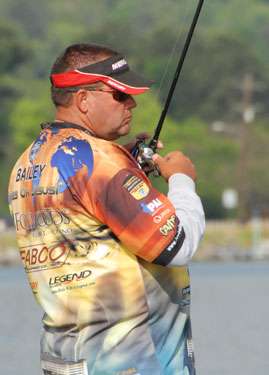
Former Bassmaster Elite Series pro Lee Bailey knows a thing or two about catching cold weather bass. He's spent much of his life in colder climates and learned through experience how to lengthen his bass-catching season.
As our waters are cooling and the bass in them prepare for winter, Bailey generally goes to small baits and light lines in an effort to tempt some bites when many of the fish are getting a bit lethargic. This is when he picks up a 6 1/2- or 7-foot medium action Powell spinning rod, a Quantum Synergy reel and spools up with 6- or 8-pound Vicious fluorocarbon line.
His bait of choice is a 1/16-ounce custom-made jig with a black living rubber skirt. Most of today's jig skirts are made of silicone, which offers many more color options, but Bailey likes a living rubber skirt for this technique because he says it's more buoyant, and that's important now when a slow fall can dramatically increase your strikes.
"I use a Yamamoto Stretch 40 worm as a trailer," Bailey adds. "I generally go with watermelon green or green pumpkin. The Yamamoto plastics have lots of salt in them, but on a 1/16-ounce jighead, they still fall pretty slow."
That slow fall is a key to Bailey's method. At this time of year, the water's pretty cold, the bass are slowing down, and a technique that's more methodical than most can pay big dividends.
Bailey focuses his efforts on the outside edges of grass lines. These may be deep or shallow.
"On some lakes, the outside edge is in just 4 or 5 feet, but in Connecticut where I've spent a lot of time, we had milfoil out to 18 feet on some waters."
The light jig and worm is a go-to bait for Bailey once the leaves have fallen from the trees. At this time of year, the water tends to be pretty clear and cold. He likes to make a long cast with the bait and actually likes it when it makes a noisy splash.
"The fish aren't very active," he points out, "but that splash will often get their attention. Then, when that bait falls slowly, it gives them a chance to swim over and grab it.
"If I don't get a hit on that initial fall, I'll let the bait go all the way to the weeds and just shake it there a few seconds. After that, I'll pop it loose from the weeds, reel it in and make another cast."
The light line and small jig might fool you into thinking this is strictly a numbers game and that the technique doesn't catch big bass. That's not true, according to Bailey.
"I've caught lots of 6- and 7-pound bass with this method and with that light tackle," Bailey says. "And it works on largemouth, smallmouth and spotted bass, too!"




